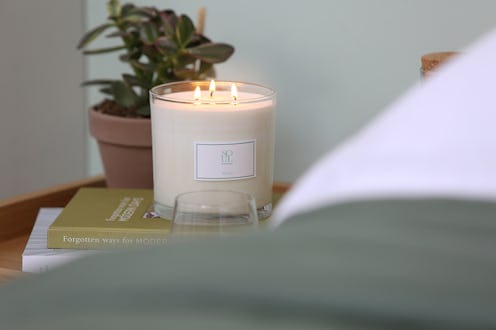According to the 2018 Life At Home study from IKEA, a 1 in 3 people who were surveyed reported feeling that "there are places where they feel more at home than the space they live in." This number, the report said, was up 15 percent compared to 2016, when only 20 percent of people they surveyed reported feeling this way. Making your home into a mindful sanctuary where you can relax and unwind is key to creating a positive environment that nurtures wellness and mental health — but, if you're currently not comfortable in your living space, it can be difficult to figure out where to start making changes. For anyone looking to change their living space for the better, these expert tips for creating a more mindful home can help.
First off, let's look into what a mindful home and mindful living actually are. Becky Snowden, an interior style advisor with Furniture Choice, tells Bustle that the terms simply "[mean] creating a living space that not only meets physical needs, but also benefits health and well-being too." Similarly, Dr. Traci Bank, a therapist and adjunct professor at Pepperdine University, told Lauren & Wolf Interior Design that creating a comfortable space can actually make you feel more connected to the world.
If you've never even considered how the design of your living space impacts your state of mind, according to a 2014 study published in Sage Journals there's evidence that everything from the type of furniture you choose and how you arrange it to the color of your walls can affect your mood. If you don't feel relaxed at home, then you definitely need to explore these ways to make your home a more mindful experience where just being there feels like an exercise in meditation.
1Color Matters
There are a lot of studies that conclude that the colors you surround yourself with can affect how you feel. If you want to create a mindful, meditative home, choose calming colors. "Try to avoid drastic color changes from room to room, instead keep the tones consistent in order to achieve a well balanced, calm flow throughout your space," Snowden advises. She suggests earthy tones such as sage, beige, and taupe. "Other alternatives include grays, light blues, and purples or if you prefer bold colors, incorporate a splash of bright shades against neutral tones."
2Clear The Clutter
Aside from color, what you surround yourself with matters too. If you haven't taken the time to declutter recently — or ever — it's time to assess the objects in your home and get rid of anything that doesn't bring you joy. According to Sherrie Bourg Carter, Psy.D., on Psychology Today, being surrounded by clutter can make you feel stressed, anxious, helpless, and overwhelmed. You might already feel that way when you leave your home, which means making your living space a stress-free sanctuary is more important than ever. When it comes to feeling more relaxed at home, less is more. And an added bonus of going clutter free is that it's much easier to keep a decluttered space clean.
3Love Your Lighting
Remember that scene in Clueless where Cher spends time creating the perfect lighting concept? As it turns out, this is a pretty important part of creating a mindful living space. Studies have shown that indoor lighting can affect your mood, which is why you might start to feel anxious in a space with overhead florescent lighting and calm down in space that's softly lit by soothing lamps. Opt for low-light bulbs that create a soft glow versus bright-as-the sun bulbs that create harsh shadows. And you don't have to spend big bucks to create an ideal lighting concept. "Dot candles and lamps around the space to bring a soft, warm tone when you’re ready to come home and relax," Snowden recommends.
4Turn To Textures
Just because you commit to living a clutter-free life doesn't mean your pad needs to appear cold and empty. Mixing textures can create a mindful feeling of warmth and relaxation so you can get your hygge on. Snowden suggests a plush sofa, soft blankets, and textured rugs to create an inviting and relaxing living space. "The perfect thing about these extra touches is that they’re cheap and easy to introduce. Not only will you set the ideal cozy tone, but your space will appear warmer. This will make it the perfect place to disconnect, and focus on re-energizing with maximum comfort."
5Bring The Outside In
Spending time in nature is a proven way to practice mindfulness, which is why it's important to incorporate natural elements into your living space. "Small additions such as wooden textures, indoor plants, and green tones are simple ways to embrace the outdoors from the comfort of your sofa," Snowden says.
As someone who's moved eleventy-million times and gotten rid of everything I own three times, I know that furnishing your pad can be pricey. But it doesn't have to be. I'm profoundly affected by my living space, and to make it mindful and relaxing on the cheap, I hit up Target for throw blankets, scour flea markets for distressed accent furniture, search for sales, and incorporate a lot of DIY ideas so I'm not spending all of my money to make my apartment a den of zen. If you need a little help getting started, Pinterest has a ton of suggestions for making your own living space more mindful, or your can check out some home-design apps for a little extra inspo. Because, it really does make a big difference.
